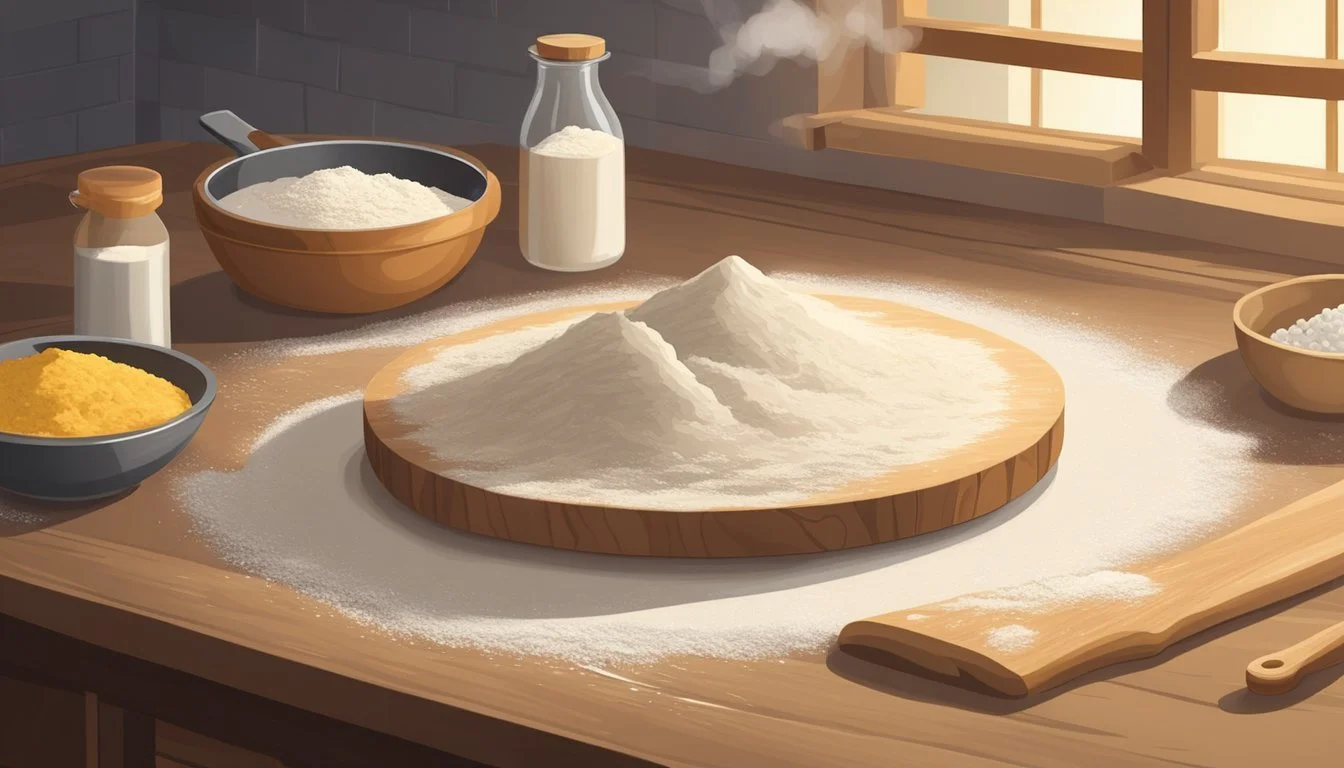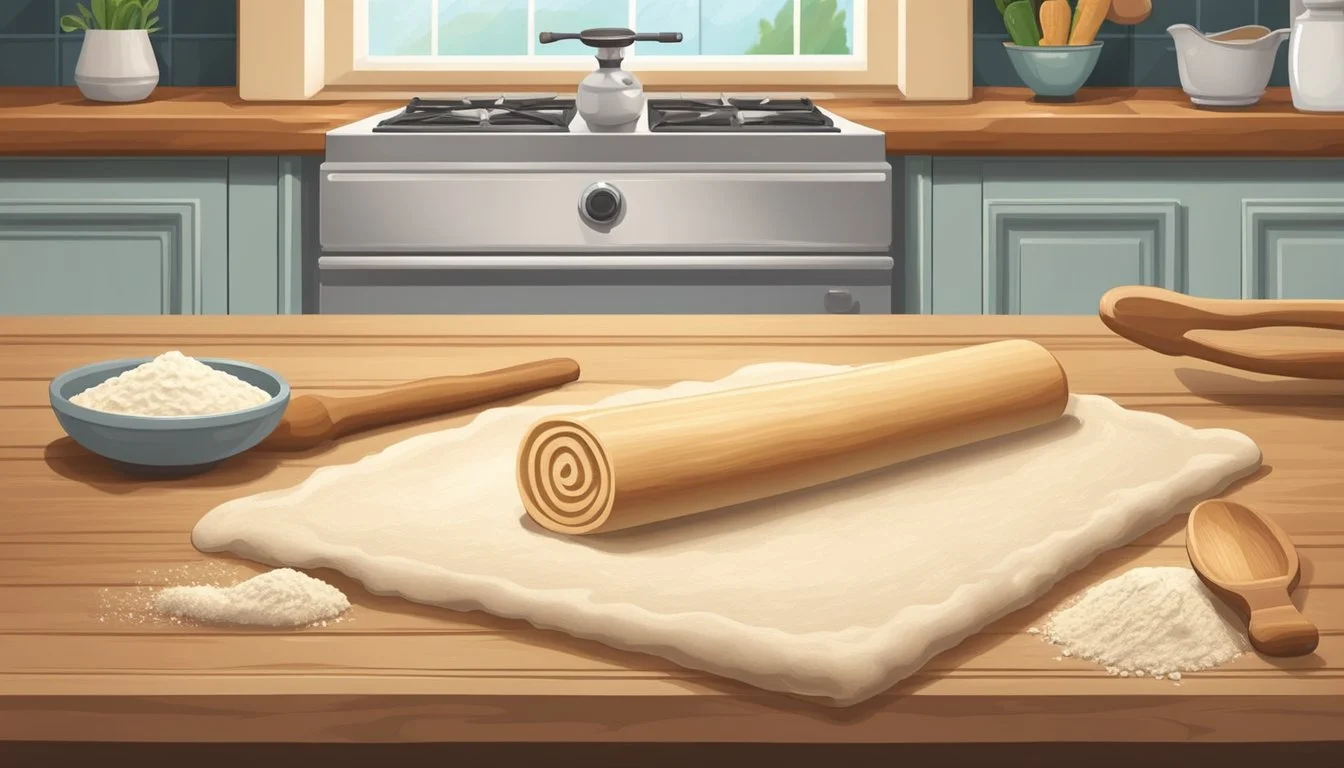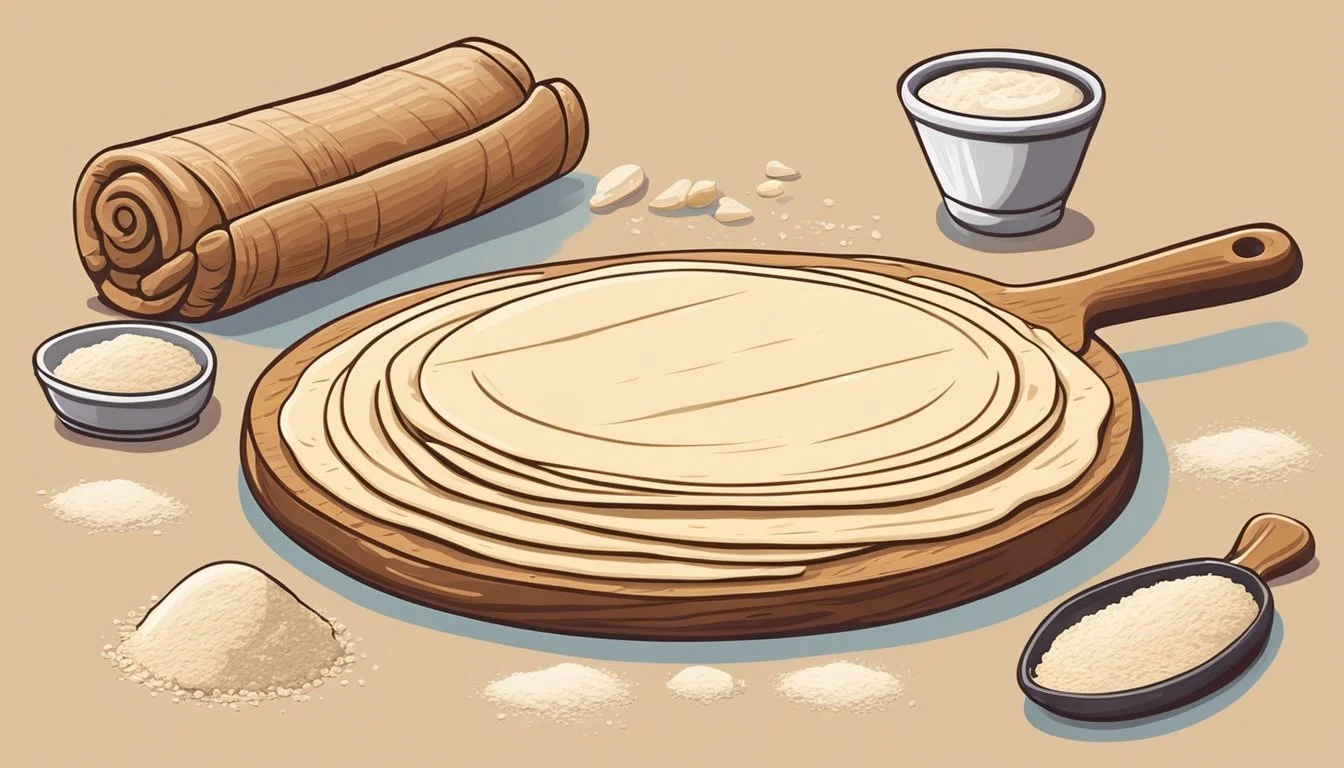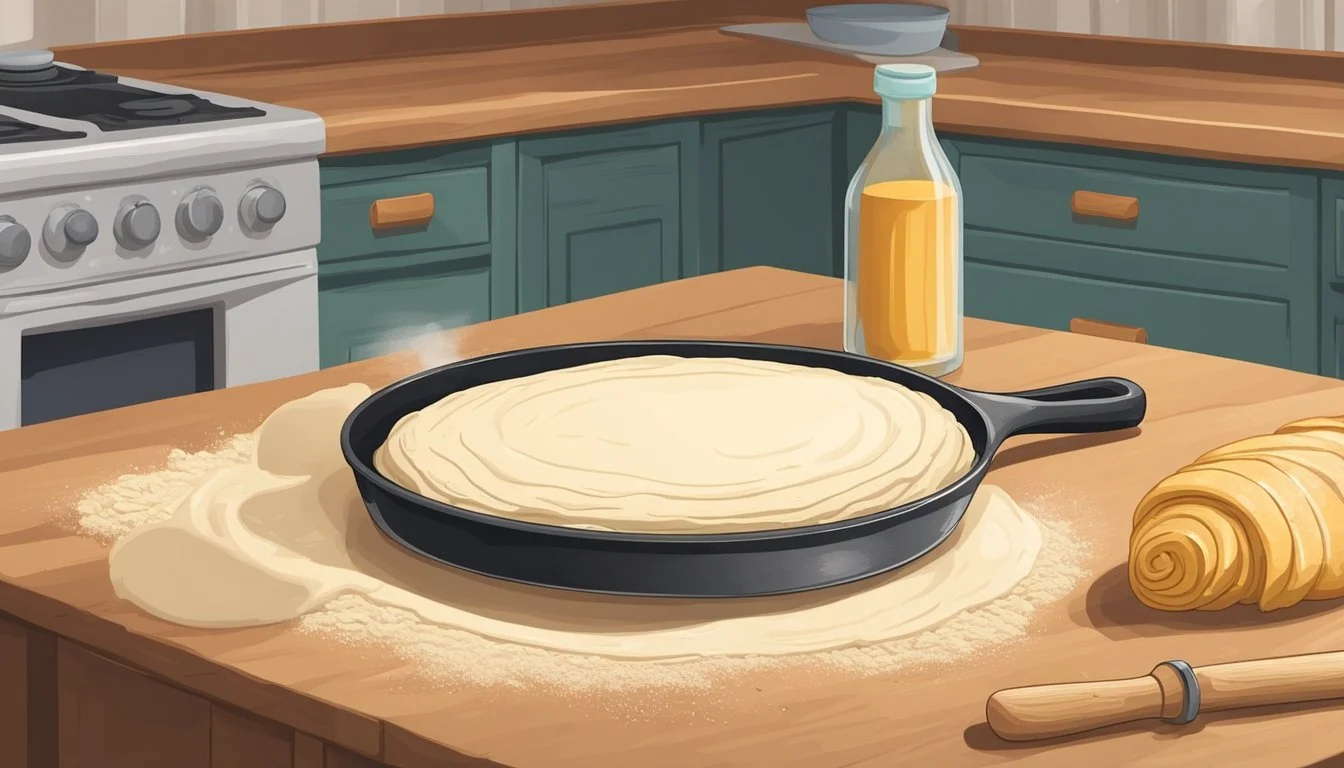How to Make Homemade Flour Tortillas
Your Guide to Perfect Tex-Mex Evenings
Homemade flour tortillas are the cornerstone of any Tex-Mex meal, offering a versatility that store-bought varieties can seldom match. They are soft, warm, and infused with a subtle flavor that elevates dishes like burritos, fajitas, and enchiladas. The art of making flour tortillas from scratch is a simple yet rewarding process. It beckons the cook into an authentic culinary experience, one that has been passed down through generations, where the act of rolling and cooking the dough is almost as satisfying as the first bite of the finished product.
The key to a perfect flour tortilla lies in its ingredients and preparation. A basic dough is formed from flour, salt, fat, and water—a combination that, when mixed and kneaded properly, yields soft, pliable tortillas with just the right amount of chew. Allowing the dough to rest is a critical step that not only improves the texture but also makes rolling out the tortillas easier. Cooking them on a hot surface then transforms the dough into golden discs, ready to be filled with an array of Tex-Mex toppings.
Embracing the homemade approach provides an authenticity to Tex-Mex night that store-bought tortillas simply can't deliver. It isn't just about the taste—making tortillas at home is an intimate process that invites family and friends to gather in the kitchen, participating in the timeless tradition of shared meals. Whether they're served alongside a sizzling skillet of carne asada or offered as the base for an array of personalized tacos, homemade flour tortillas serve as a heartfelt homage to Tex-Mex cuisine.
Ingredients Overview
Making homemade flour tortillas for a Tex-Mex night begins with gathering the proper ingredients. The quality and type of each ingredient can affect the texture and flavor of the tortillas.
Flour: All-purpose flour is the standard choice for texture and flexibility, but one can also use whole wheat flour for a healthier option, though it may alter the classic taste and texture.
Salt: Fine kosher salt is preferred for its flavor and its ability to dissolve easily into the dough.
Baking Powder: This is a crucial leavening agent in tortilla making, giving them their characteristic puff.
Fat: Traditionally, lard is used in tortilla recipes to provide a distinct richness. However, substitutes like vegetable shortening, butter, or even vegetable oil can be used. The fat content helps in achieving a flaky texture.
Water: Warm water is essential in achieving the right dough consistency. It combines with the flour to form a pliable dough.
Here is a summarised list of ingredients with typical measurements for making about 8 tortillas:
Ingredient Measurement All-purpose flour 600g Kosher salt 9g Baking powder 6g Lard (or butter) 70g (85g if using butter) Warm water About 1 1/4 cups (adjust as needed)
Remember, the exact measurements can vary slightly depending on the specific recipe, and adjustments may be necessary based on factors such as flour type or environmental humidity.
Utensils and Cookware
When making homemade flour tortillas for a Tex-Mex night, several kitchen tools and pieces of cookware are essential for ease and quality. The cook requires a large bowl for mixing the dough ingredients. In some cases, a food processor can expedite the mixing process, blending the dry ingredients before adding fats and liquids.
For the rolling process, a rolling pin is crucial to shape the dough into thin, round tortillas. Those who prefer a more traditional or uniform approach might opt for a tortilla press, although it's more commonly used for corn tortillas.
To cook the tortillas, one needs a heated surface. Choices include a skillet, griddle, or comal—each can produce excellent results. A cast-iron skillet or cast-iron griddle is often recommended due to their superior heat retention and distribution.
Post-cooking, tortillas are best kept warm and pliable. A tortilla warmer ensures the tortillas remain at an ideal temperature for serving. If one isn't available, simply wrapping them in cloth inside a container can suffice.
To handle the dough without sticking, plastic wrap or parchment paper is advisable. They help in resting and rolling out the dough, protecting the countertop and the rolling pin.
Lastly, for those incorporating a machine for kneading, a stand mixer with a dough hook can knead the dough to the perfect consistency, while a pastry cutter may be beneficial when manually incorporating fat into flour.
Cookware/Utensil Purpose Large bowl Mixing ingredients Food processor Blending dry ingredients Rolling pin Shaping the dough Skillet/Griddle/Comal Cooking the tortillas Cast-iron variants Even heating and cooking Tortilla press Uniform tortilla shaping Tortilla warmer Keeping tortillas warm Plastic wrap Handling and rolling dough Stand mixer Kneading dough Pastry cutter Incorporating fat
These tools support an efficient and successful cooking experience, leading to delicious homemade flour tortillas that are sure to impress at any Tex-Mex gathering.
Dough Preparation
The process of making tortilla dough involves three critical stages: mixing the ingredients to form the dough, kneading to develop the gluten, and resting to ensure a soft texture and pliability.
Mixing the Ingredients
In dough preparation, one starts by combining all-purpose flour with a pinch of salt for flavor. The ingredients are then mixed with a form of fat—usually lard, shortening, or oil—and warm water to bring the mixture together. The ratio of the ingredients is vital to ensure a balanced dough consistency; typically, for every 2 cups of flour, one uses about 3/4 cup of warm water and 2 tablespoons of fat.
Kneading the Dough
Once the ingredients are mixed, the dough requires vigorous kneading by hand or with a dough hook attachment on a stand mixer for about 3 to 10 minutes. Proper kneading is crucial as it activates the gluten within the flour. The goal is to achieve a smooth, cohesive dough that's not sticky or overly dry. A well-kneaded dough should spring back when pressed with a finger.
Resting the Dough
After kneading, the dough needs to rest, covered with a damp cloth or plastic wrap to prevent drying. This rest period can range from 10 to 30 minutes, which allows the gluten to relax, making the dough easier to roll out and contributing to the final tender texture. For best results, the dough should rest at room temperature. The resting step also helps ensure even cooking when the tortillas are later placed on a hot surface.
Rolling and Shaping
Making flour tortillas from scratch involves a tactile process that is simple yet crucial to achieve the perfect texture and shape. It requires dividing the dough, rolling it into balls, and flattening it into thin, round disks on a work surface.
Dividing the Dough
After resting the dough, the cook divides it into even portions, ensuring that each tortilla cooks uniformly. They should portion the dough into 8 equal parts for standard-sized tortillas. Using a knife or dough scraper helps maintain consistency in size.
Rolling the Balls
Each portion of dough is then shaped by hand into a smooth ball. The cook rolls the portion between their palms or on the work surface until it's round and free of creases, which is critical for even rolling out later.
Flattening the Dough
Finally, the cook flattens the balls into tortillas using a rolling pin. They start from the center of the ball, applying even pressure and rolling outwards. They rotate the dough a quarter turn after each roll to maintain an even, circular shape. It is typical to roll out the dough to a thickness of about two millimeters, and a width of about 6-8 inches in diameter, depending on the desired tortilla size.
Cooking Process
Making homemade flour tortillas requires attention to the heat and timing during the cooking process. Using the right cookware and temperature ensures an even cook and the perfect texture.
Heating the Cookware
One begins by selecting the appropriate cookware; cast iron skillets or a nonstick griddle are most suitable for even heat distribution. The cookware must be preheated over medium-low heat for 5 minutes to ensure a consistent temperature across the cooking surface. Using hot water in the dough assists in creating tender tortillas, a detail the cook should not overlook in preparation.
Cooking the Tortillas
Once the skillet or griddle is ready, place a dough ball in the center and cook for about 30 to 60 seconds on each side. The tortilla should start puffing within a few seconds if the cookware is at the correct temperature. The tortilla is flipped when brown spots appear on the underside. It's essential to handle the tortillas with care to avoid tearing. Cooks may adjust the heat as needed—too high a heat might burn the tortillas while too low a temperature will create hard, dry tortillas.
Storage and Preservation
Ensuring the freshness of homemade flour tortillas is vital for maintaining their softness and flavor. Proper storage techniques can extend their shelf life, whether one plans to use them within a few days or save them for future Tex-Mex gatherings.
Storing Fresh Tortillas
For immediate use, storing tortillas in the refrigerator is recommended. They should be kept in an airtight container or sealed in a plastic bag to prevent drying out. Refrigeration can keep tortillas fresh for up to a week. One can also keep them at room temperature in a cool, dry place if they plan on consuming the tortillas within a day or two. This helps to maintain the texture and taste without the tortillas becoming hard or stale.
Freezing for Later Use
For long-term storage, freezing is a suitable option. One should individually separate the tortillas with parchment paper to prevent sticking and then wrap them tightly in plastic wrap. After wrapping, place them in a zip-top freezer bag or an airtight container to prevent freezer burn. Label the bag or container with the date to keep track of how long the tortillas have been stored. Tortillas can be frozen for up to two to three months. When ready to use, thaw them in the refrigerator overnight or at room temperature for a few hours.
Serving Suggestions
When it comes to enjoying homemade flour tortillas, they serve as the backbone to a wealth of Tex-Mex dishes. Freshly made tortillas provide a warm, pliable foundation perfect for a variety of fillings and uses. Here's how one can incorporate them into a Tex-Mex night spread:
Tacos: Their versatility shines in tacos. Fill them with your choice of protein, fresh vegetables, a sprinkle of cheese, and a dollop of salsa. They can be lightly grilled for added texture.
Enchiladas: Roll tortillas around a savory filling, lay them in a baking dish, smother with sauce and cheese, and bake to perfection.
Quesadillas: Use tortillas to create quesadillas by sandwiching cheese and other ingredients between two tortillas and toasting until the cheese is melted and gooey.
Burritos: Stuff tortillas with a combination of rice, beans, cheese, and meat, rolling them into a neat package to be eaten by hand or covered with sauce and baked.
Fajitas: Serve them alongside strips of seared meat and sautéed peppers and onions, allowing everyone to make their own fajita wraps.
For a morning twist:
Breakfast Tacos: Fill tortillas with eggs, cheese, and your choice of breakfast meats for a satisfying start to the day. Add a side of salsa for a kick.
Remember, homemade flour tortillas on Tex-Mex night elevate the dining experience with their fresh taste and soft texture. Whether wrapped, rolled, or folded, they are sure to please the palate.
Variations and Substitutions
When making homemade flour tortillas, individuals have the flexibility to experiment with different flours and fats to suit dietary restrictions or flavor preferences. Here's how one can adapt the traditional recipe.
Alternative Flours and Fats
Flours:
All-Purpose Flour: The standard choice for a classic texture.
Whole Wheat Flour: Offers a nuttier flavor and more fiber.
Gluten-Free Flour Blends: Ensures tortillas are gluten-free, though the texture may vary.
Fats:
Lard: Traditional fat that contributes to a flaky texture.
Shortening or Butter: Can be used for a richer flavor.
Vegetable Oils: Such as olive or canola oil for a vegan option.
Flavor Additions
Savory Enhancements:
Spices: Cumin, paprika, or garlic powder to compliment Tex-Mex dishes.
Herbs: Finely chopped cilantro or parsley for a fresh taste.
Sweet Variations:
Sugar and Cinnamon: For a sweet, dessert-style tortilla.
Vanilla Extract: Adds a subtle, sweet fragrance suitable for fruit wraps.
Tips and Tricks
In making homemade flour tortillas, one can elevate their Tex-Mex night with tortillas that are soft and boast an authentic texture. A handful of tips and an understanding of the process can make this culinary endeavor easy and rewarding.
Achieving the Perfect Texture
The texture of a flour tortilla is paramount; it should be soft yet sturdy. Achieving this starts with the dough. One must ensure that the fat—be it shortening, lard, or butter—is well incorporated into the flour mixture until the consistency is crumbly. This allows for even fat distribution, which is crucial for the tender texture of the tortilla. The water added should be warm to help the dough become more pliable.
Use Warm Water: Warm water facilitates gluten development.
Even Fat Distribution: Work the fat into the flour until the mixture is consistent.
Additionally, after the dough is mixed, it's important to let it rest. This resting period relaxes the gluten, making the dough easier to roll out and less likely to snap back. Ideally, one should rest the dough for a minimum of 30 minutes before shaping.
Troubleshooting Common Issues
Sometimes, despite best efforts, one might encounter challenges in the process of making tortillas. Here's how to troubleshoot some common issues:
Tortilla too dry or tough: Add a bit more fat to the dough and ensure it is not overcooked on the skillet.
Tortilla not forming bubbles: Make sure the skillet is properly heated before cooking the tortillas. If it's not hot enough, the tortillas won't puff up.
Key to resolving texture issues is understanding the interplay between ingredients, dough handling, and cooking process. One must observe the dough and cooked tortillas closely and adjust their technique accordingly. Monitoring heat levels and cooking time vigilantly can prevent under or overcooking, which compromises texture.
Tex-Mex Night Recipes
For an authentic Tex-Mex night, the cornerstone is a good foundation of homemade flour tortillas. They are the versatile canvas for a variety of dishes that will transport taste buds to the heart of Texas with a Mexican twist.
Ingredients:
Flour
Salt
Shortening or lard
Warm water
To craft the tortillas, begin by blending flour with salt and fat—vegetable shortening or lard works—until the mixture is crumbly. Gradually add lukewarm water and knead to form a smooth dough. Shape into even balls and let them rest to ensure pliability. Roll out thinly on a surface and cook in a hot skillet until each side is slightly browned with characteristic spots, signaling they are ready for action.
These tortillas can wrap up savory carne asada or can be crisped into taquitos. As Tex-Mex cuisine is all about robust flavors and hearty meals, don't forget to have warm, melting queso ready for dipping or drizzling.
In Texas, and increasingly beyond, the Cinco de Mayo celebrations often highlight these Tex-Mex staples. Whether it’s at a Mexican restaurant or at home, the goal is the same: serve food that's both comforting and exciting.
Tex-Mex Night Classics Suggested Filling/Pairing Homemade Flour Tortillas Carne asada, chicken, veggies, or beans Queso Served with tortilla chips Carne Asada Grilled, seasoned beef Taquitos Rolled tortillas with meat or cheese
Embrace these recipes and one’s Tex-Mex night will be talked about until the next Cinco de Mayo!
Cultural Significance
In the culinary landscape of Tex-Mex cuisine, flour tortillas are more than just an ingredient; they are a cultural icon. Originating from the fusion of Mexican food traditions with those of Texas, these tortillas have become a staple for numerous dishes, celebrated not only in everyday meals but also during festive occasions such as Cinco de Mayo.
The process of making authentic Tex-Mex flour tortillas is often regarded with respect and memory, carrying the essence of family traditions passed through generations. Unlike Mexican restaurants, where corn tortillas might be the norm, Texas's influence has popularized the flour variant, making it a signature element of the region's food culture.
These soft, versatile discs epitomize a shared heritage between Northern Mexico and Southern Texas. They anchor a variety of Tex-Mex dishes, from classic quesadillas to heartwarming burritos. Their preparation - from the rolling of the dough to the meticulous cooking on a hot surface - is a testament to the hands-on approach that is cherished in authentic Tex-Mex cooking.
Despite the simplicity of their ingredients, flour tortillas are a testament to the culinary adaptability and creativity that define Tex-Mex cuisine. Thus, they hold their place at the table with the same confidence and warmth that they bring to the countless meals they complement.
Health and Nutrition Considerations
When making homemade flour tortillas, one should consider the health impact of the ingredients used.
Salt: It should be used judiciously to limit sodium intake. While essential for flavor, excessive salt can lead to health complications such as hypertension.
Flour Choices:
Whole Wheat Flour: A healthier alternative to white flour, whole wheat flour provides more fiber and nutrients, which aids in digestion and can contribute to a feeling of fullness.
Gluten-free Options: For those with celiac disease or gluten intolerance, gluten-free flour blends are available and should be chosen to avoid adverse reactions.
Water Absorption: The type of flour chosen impacts how much water is absorbed, which will affect the texture and nutritional content of the tortillas. Whole wheat flour, for instance, generally requires more water than white flour due to its higher fiber content.
For individuals looking to increase their fiber intake while enjoying Tex-Mex night, using whole wheat flour is a beneficial choice. In contrast, for those who must avoid gluten, a variety of gluten-free flour options exist that will still allow for delicious and flexible tortillas.
In conclusion, one's dietary needs and health goals greatly influence the ingredients for homemade tortillas. Being informed about these factors ensures that both the flavor and nutritional needs are adequately addressed.
The History of Tortillas
Tortillas have been a staple in Mexican cuisine for thousands of years, traditionally made from maize (corn). They were an integral part of the Aztec and Mayan diets and have since become synonymous with Mexican and Tex-Mex foods around the globe. Corn tortillas were made by grinding corn kernels into a dough called masa.
With the Spanish conquest and the introduction of wheat, flour tortillas were born. Flour, being a non-native grain to the Americas, became prevalent in the northern regions of Mexico, where corn did not grow as abundantly. As a result, flour tortillas became common in Mexican-American border states, leading to their association with Tex-Mex cuisine.
Flour Tortilla Evolution:
16th Century: Wheat introduced by Spanish settlers.
Northern Mexico: Flour tortillas gain popularity due to wheat's adaptability in the region.
Tex-Mex Fusion: The blending of traditional Mexican recipes with American tastes.
Flour tortillas are known for their larger size, softness, and flexibility, which make them ideal for burritos, a Tex-Mex innovation. In contrast, corn tortillas are traditionally smaller and used in dishes like tacos and enchiladas.
Corn Tortillas: Made from masa, smaller, used in traditional Mexican dishes.
Flour Tortillas: Made from wheat flour, larger, flexible, used in Tex-Mex cuisine.
While corn tortillas remain a symbol of Mexican heritage, flour tortillas are an example of the culinary fusion that defines Tex-Mex cuisine. They both continue to be enjoyed in various dishes, each contributing its unique texture and taste to the rich tapestry of Mexican and Tex-Mex fare.
Homemade vs. Store-Bought
When hosting a Tex-Mex night, one might debate whether to use homemade or store-bought flour tortillas. The decision can significantly affect the taste, texture, and overall authenticity of the meal.
Homemade Flour Tortillas are typically praised for their freshness and lack of preservatives. Those who prepare tortillas at home can control the ingredients, ensuring they meet specific dietary needs or preferences such as organic or non-GMO flour. While they do require time and effort, the process of making flour tortillas is straightforward and can be an enjoyable part of the cooking experience.
Feature Homemade Tortillas Store-Bought Tortillas Taste & Texture Fresher flavor; soft, pliable texture Often less flavorful; texture may be less appealing Ingredients Control over ingredients; option for healthier fats May contain preservatives and other additives Time & Effort More time-consuming; involves mixing and rolling Quick and convenient; no preparation required Customization Can adjust size, thickness, and flavor Limited to available varieties Shelf-Life Best consumed fresh; shorter shelf life Typically lasts longer due to preservatives
Homemade tortillas give cooks the opportunity to craft their tortillas to preferred size and thickness, a luxury not afforded by packaged varieties. This adaptability in preparation allows for a personalized touch to each recipe.
While store-bought tortillas are easy to use and provide a great deal of convenience, the flavors and texture may fall short when compared to their homemade counterparts. The mass-produced nature of store-bought tortillas often leads to a more standardized, less distinctive taste.
One must weigh the value of the authentic, fresh experience of homemade tortillas against the convenience and time saved with store-bought options. Either choice has its merits, but for an authentic Tex-Mex experience, homemade flour tortillas can bring an unparalleled level of freshness and personalization to the table.
FAQs
What's the best way to knead tortilla dough?
One should begin by placing the dough on a well-floured surface. The dough must be kneaded for about 5 minutes or until it achieves a smooth and elastic texture.
How long should the dough rest before rolling out the tortillas?
After kneading, the dough should ideally rest, covered with a clean dish towel or plastic wrap, for at least 20 to 30 minutes. This helps the gluten relax and makes rolling easier.
Is a tortilla press necessary for making tortillas?
While not mandatory, using a tortilla press can expedite the rolling process and help achieve uniform thickness. Without a press, one can utilize a rolling pin.
Can I cook tortillas without a cast iron skillet?
A cast iron skillet is preferred for cooking tortillas due to its consistent heat distribution, but any non-stick skillet or flat griddle will suffice. Cook each side of the tortilla until brown spots appear, generally 30 to 60 seconds per side.
How do I store homemade tortillas?
Tortillas should be stored in an airtight container or zip-lock bag and can be refrigerated for additional longevity.
Are there gluten-free options for tortilla making?
Yes, one can make gluten-free tortillas by substituting wheat flour with gluten-free flour blends designed for baking.
Can I freeze homemade tortillas for later use?
Certainly. Separate the tortillas with parchment paper and store them in a freezer-safe bag. They can be reheated in a skillet or microwave when needed.







